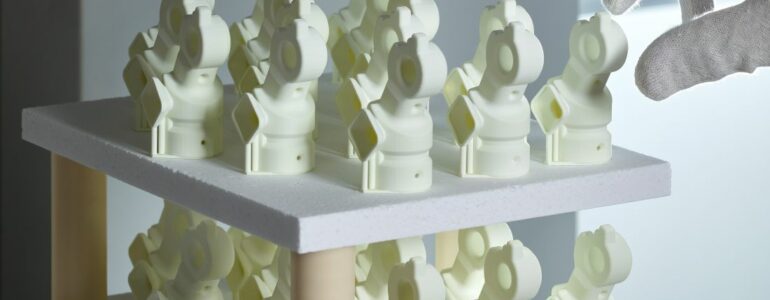25/05/22

After enlarging the printing build volume of the Admaflex300, a logical step to upscale to mass production would be a larger integrated debinding and sintering furnace. Therefore in 2022 Admatec introduced a new integrated debinding and sintering furnace, with enlarged inner volume, dramatically increasing the throughput and efficiency in technical ceramic 3D printing and postprocessing.
Technical ceramics 3D printing is probably the most advanced segment in Additive Manufacturing and perhaps the hardest to implement. Looking at material properties, usually ceramics are used when other materials fail, because of limited hardness, corrosion resistance or temperature resistance. To shape technical ceramics, there are several solutions, such as pressing, which has limited design freedom, or injection moulding which requires to produce first a mould. Technical ceramics 3D printing can offer solutions to produce complex shapes directly from a CAD file, without the need of a mould, with comparable material properties as traditionally produced ceramics, when using the appropriate 3D printing technology, materials and furnaces.
3D printed high performance ceramic parts are used in many applications, such as aviation, aerospace, medical tools, R&D, catalysis, refractories, energy, chemical industry, electronics, semiconductor, CO2 capture, refractories, aesthetics, jewellery, opto-mechatronics, and many more. Next to the full dense ceramics, also porous ceramics are available, such as bonelike materials for patient specific medical implants and leachable ceramics to produce ceramic cores and shells for investment casting.
If the aim is to have full dense technical ceramic products with high strength and smooth surfaces, ceramic particles with very small grain sizes are needed, as these allow full densification during sintering. Very fine powders cannot be processed safely in a dry powder bed, however a proven solution is to work with pastes or slurries. By using slurries consisting of highly ceramic filled UV sensitive resins, 3D printing is possible with high resolutions (<40 um) and after postprocessing in debinding and sintering furnaces, high quality parts can be obtained.
When printing ceramics, a printing system is needed which can handle high viscosity slurries. In 2013, Admatec developed a printing technology which combines tape casting (for slurry depositioning) with Digital Light Processing (UV curing using stereo lithography) to produce ceramic parts. Since the introduction of the Admaflex130 printer in 2016, many machines using this Admaflex technology have been delivered worldwide, at renowned ceramic producers, ceramic 3D printing contract manufacturers, Universities and governmental labs, who have proven the ability to shape and sinter high quality parts with excellent material properties and narrow tolerances.
When the lithography based ceramic additive manufacturing technologies and systems were introduced in 2013, typical projection areas were 96×54 mm at a resolution of 50 µm. Debinding and sintering was executed in two separate furnaces, resulting in a thermal process of almost 2 weeks. To answer the requests from the market for more efficient serial production, Admatec developed larger printing machines, currently enabling projection areas up to 260×220 mm in one single machine. The DLP printing process which cures a next layer of a full build platform in a few seconds, in combination with tape casting to deposit a new slurry layer, allows to increase printing speeds up to 300 layers per hour. Materials have been optimised for faster debinding times and higher final density and mechanical properties.
Since 2018, Admatec offers a compact integrated debinding and sintering furnace, specially designed for post-processing of 3D printed technical ceramics. This furnace allows safe, controlled debinding and accurate sintering with excellent temperature uniformity. With a useful volume of 180x180x200 mm and maximum temperature of 1700°C, this furnace is a cost-effective and efficient solution to debind and sinter small parts printed in oxide ceramics. After enlarging the printing build volume of the Admaflex machines to 260x220x500 mm, a logical step to upscale to mass production, has been the introduction of a larger integrated debinding and sintering furnace. Therefore in 2022, Admatec introduced a new integrated debinding and sintering furnace, with inner volume of 400x400x400 mm.
All these improvements, in combination with specially designed integrated debinding and sintering furnaces, currently allow to produce a set of 3D printed technical ceramic parts, from CAD design till sintered end-use part, in less than 7 days. With a maximum temperature of 1700°C and useful inner volume of 64 litres, the new furnace has almost 10 times the size of the compact integrated furnace, dramatically increasing the throughput and efficiency in technical ceramic 3D printing and postprocessing.